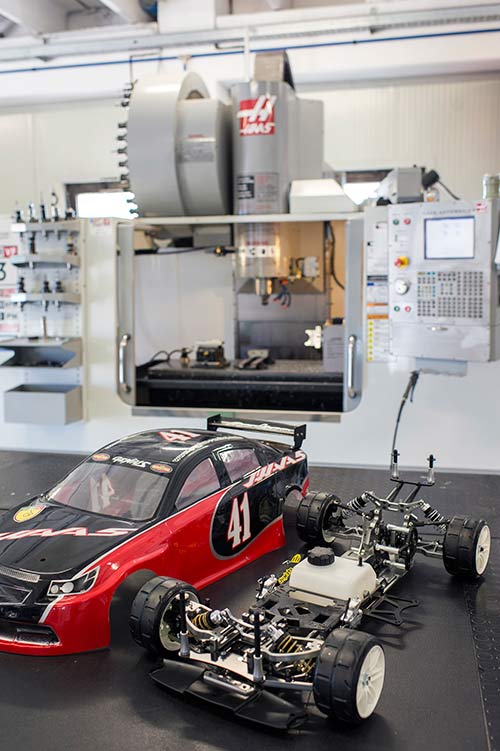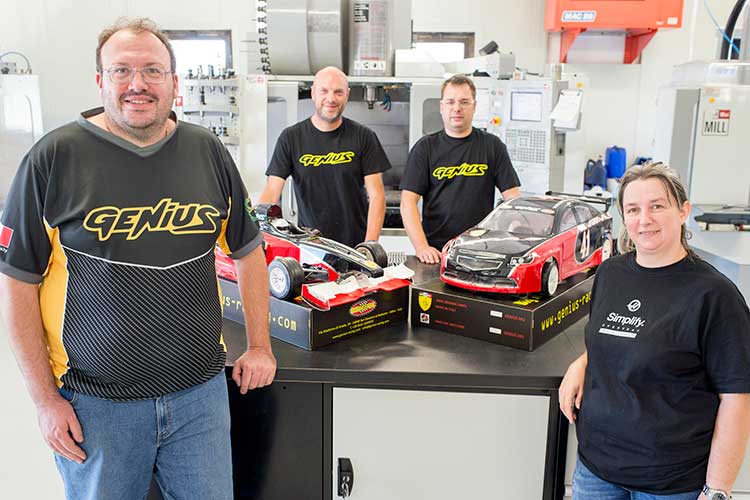Based near Udine in the northeast of Italy, Haas customer Modeltek is a successful international motorsport business supplying teams and privateers all over the world. The fact that the cars and parts it produces are one-fifth scale doesn’t make the company’s achievements any less impressive.
To her credit, company director Paola doesn’t appear to be the least bit put out, even though Zeno frequently uses words like love and passion to describe his feelings for the machines.

“I was at a trade show when I first saw her,” he says, reminiscing not about how he met Mrs. Noacco, but about how he came across the company’s first Haas, a Super Mini Mill. “I immediately liked the simplicity of the machine; the control was very easy to use, and as someone with no experience of CNC machining, I was worried that I might buy a machine and then not know how to use it.”
Turns out, he worried unnecessarily. “I told myself I’d give it a go, and if I’d made a mistake, I’d sell the machine and go back to using subcontractors to make our parts. I’m glad I kept it. I think it’s a great product. After a few weeks, I was completely confident, and I knew all the machine’s functions and capabilities.”
Modeltek’s 1:5 scale model “‘professional” racing cars, sold under the name Genius RC, cost around €2000. Each is a painstaking replica of a full-scale counterpart, with custom designed and made differentials, gearboxes, hydraulic disc-brake systems, drive shafts, and suspension. All of the parts are created to tight and specific criteria – size, weight, materials, etc. – laid down by the sport’s governing body, the European Federation of Radio Operated Automobiles (EFRA).
In the years before he started his company, Zeno was a hobbyist who lived for the weekends, when he and his friends would race the scale models they made at home in their spare time. Of course, as history now shows, the models Zeno made were exceptional. So much so that his fellow racers – his competitors – would often ask him to make parts for their cars.
“Little by little, I began modifying and making a few of the more simple parts on my cars. Eventually, I made almost all parts, not only for my cars, but also for anyone else who wanted them.”
Thanks to the Internet, and the close-knit community of fellow scale-racers, Zeno’s customers were able to easily track him down. The orders began to roll in. “It’s a niche market,” he says, “so production volumes are not huge, even though we sell worldwide. However, we now make around four hundred full cars a year: the ‘Touring’ model – designed to resemble a BMW, Mercedes, or Alfa Romeo – as well as the ‘F1’ model.”

Given such a positive early experience with the Haas Super Mini Mill, Zeno didn’t need to look far for his next CNC machines. “We bought a Haas VF-2SS, a VF-3SS, and a standard VF-2,” he says. “So, now we have four Haas machines, a dedicated, fully trained operator, Mr. Clemente Pocovaz, and no need to use subcontractors or buy-in parts except for the motor – from Japan – and the fiberglass body shell.”
On a bench in an assembly area adjacent to the machine shop, there are several chassis in various states of build, at different stages on the production line. The parts – even a beautifully miniaturized centrifugal clutch – look just like those used on full-sized race cars, and they behave very similarly.
“Like when engineers are designing a full-scale vehicle, we begin a project by doing the maths,” says Zeno. “For example, with a new, self-locking differential, we work out the forces generated by the motor, and the desired power and torque output of the car, and we use these figures to create parts with the correct weight, dimensions, etc.”

The final prototype parts are designed on a CAD system, then cut on the Haas machines. It’s a thorough process, and the end results, if the numbers are good, are steel, titanium, and aluminium creations, many of which look like jewelry and are as precise as wristwatch components.
“We have lots of small parts, which we usually machine on the Super Mini Mill,” says Zeno. “But, we also have parts such as the chassis floor, the plate on which everything else is mounted. It’s almost 700 mm long, which is why we need the VF-3. In fact, the best size Haas machines for us now are the VF-2SS and the VF-3SS, as they give us plenty of table space, and the flexibility to make large or small parts. Production batches are typically around two hundred off, which we can machine in less than eight hours.”
Once all the prototype parts are assembled into a complete vehicle, the testing phase begins.
“We build five working models for the race team,” says Zeno. “Over the course of a year, we will refine the new car and fine tune it until we have something we’re happy with, and that is as close as possible to the minimum weight of ten kilos.”
In many ways, the world of large-scale model racing is very similar to the real racing world. “As well as providing cars and parts for customers, we have a race team,” says Zeno: “Genius Racing! We’ve also built next door a two million Euro racetrack equipped with telemetry. We travel all over Europe and the rest of the world; there’s a large following amongst the automotive companies. I have many friends at Ferrari, for example, and everyone takes it very seriously. Although, we have a lot of fun, too.” After all, for most people, it is a pastime.
Except, that is, for Modeltek and its four employees. “We may be a small company, but we see some great opportunities, now that we’ve developed some good design and machining skills, including work with the Italian Air Force. That would be exciting, but at the moment, we have little time for anything except the model cars. It sometimes feels like we work twenty four hours a day!”
If you spend most of your waking hours in a business running CNC machine tools, life is sweeter if the machines are easy to use and you like them – a lot.
“I’m a little in love with the Haas brand and the Haas machines,” confides Zeno Noacco. “They’re affordable, easy to use, and reliable. In fact, I don’t think we’d be running this business now if we hadn’t discovered Haas.”


